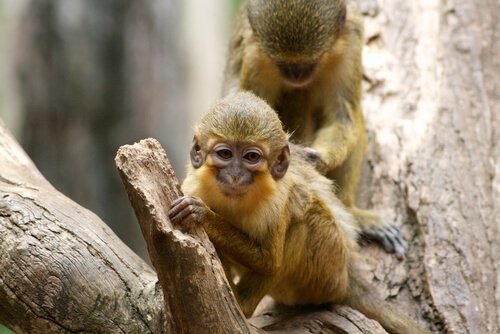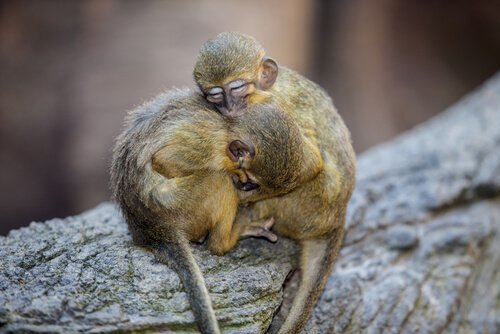Talapoin: characteristics, behavior and habitat
Talapoin is a species of primate whose biology and characteristics are little known , but it is still an animal victim of illegal trafficking whose specimens appear in Europe.
Characteristics of talapoin
The word talapoin includes two primates of the genus Miopithecus living in central Africa: the talapoin of Angola and the talapoin of Gabon. Both are characterized as small primates, which are around the kilo in weight and 40 centimeters in length. This makes it the smallest African monkey, although it is easily surpassed by various species of marmoset, which are found in South America.
Its appearance slightly resembles that of the green monkey, although of much smaller size, since the green monkey can weigh between six and eight times more than this small African primate: have a brown coat with greenish tonalities reminiscent of green monkey, especially in the back area and the head .
Like most of these monkeys, they have a recognizable face without fur that allows them to show a rich facial expression and that makes each animal can distinguish itself.
In the case of Northern Talapoin or Gabon, the skin of the face is flesh colored. Meanwhile, the skin of the southern talapoin or Angola is black, as are its ears, which have the same color.

After a gestation of about five months, a baby is born that eats solid in just six weeks. The birth of a single calf is normal in primates, and responds to very pronounced care by mothers compared to other taxa. At three months, the young have a great degree of independence. They can live between 20 and 30 years, especially in captivity.
Talapoin behavior
Talapoin lives in numerous groups of up to 100 individuals and, Although it usually sleeps on trees in these large congregations, during the day it is usually divided into small groups to look for food, which prevents conflicts over food have a great escalation.
The groups are composed of numerous males and females with their young. They are animals that lack territorial behavior and have a large vocal repertoire , although less rich than the animal communication of other monkeys.
Talapoin is an omnivorous primate, which it feeds on fruits and seeds as well as on aquatic plants or eggs, as well as on insects and other invertebrates. He has even been seen eating small rodents and birds, although occasionally.
Although greatly linked to trees, it seems that Angola's talapoin has more terrestrial behavior than its relative of Gabon , possibly due to the difference in resources that its niches have.

Talapoin habitat
Talapoin is a primate closely linked to trees, a diurnal animal found only in forests and thicker jungles. Interestingly, is one of the few primates that has no problems with getting wet, and has even been seen swimming in search of food.
Therefore, this primate usually lives in areas close to bodies of water. In the case of Gabon talapoin or northern talapoin, this animal lives in areas riparian of Cameroon, Equatorial Guinea, Gabon and the Democratic Republic of the Congo.
The southern talapoin, however, lives in the miombo. In particular, Angola's talapoin can be found south of the Congo River, in the republic of the same name and in Angola.
Although none of the talapoin species is threatened , this has made it barely protect itself from illegal traffic. Because of its small size, it is a species captured to try to sell itself in Europe as a pet. African primates in central Africa are especially dangerous, as they are an area where there are important and dangerous zoonoses for the human species , which are not controlled in animals that come to Europe illegally. p>


